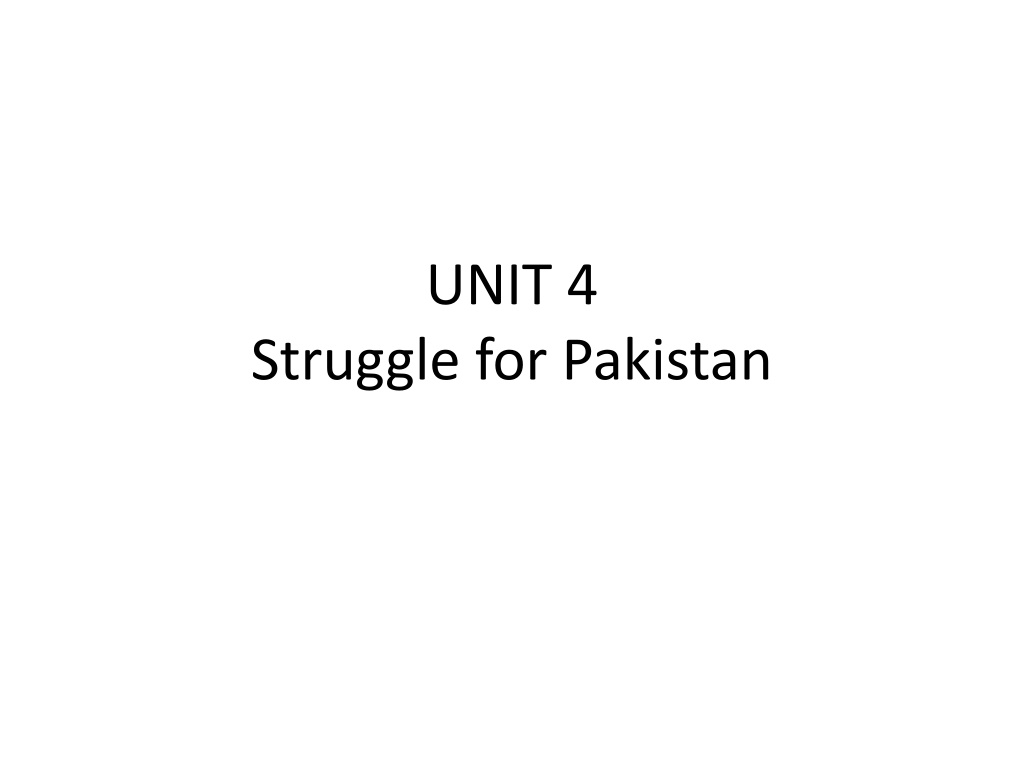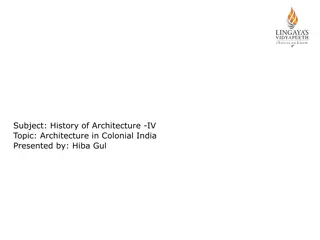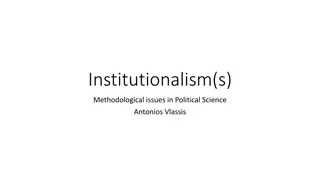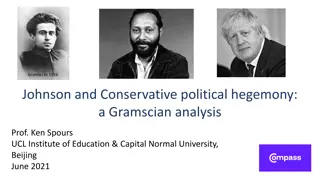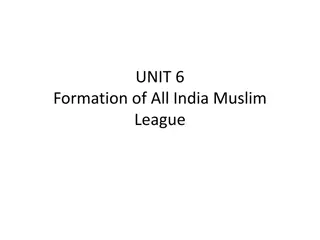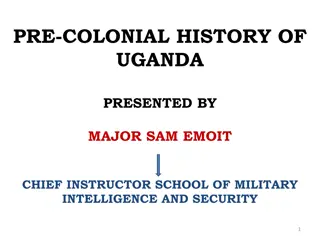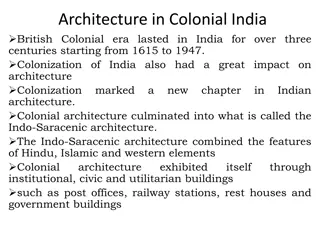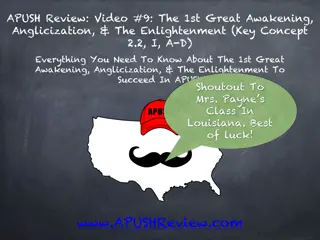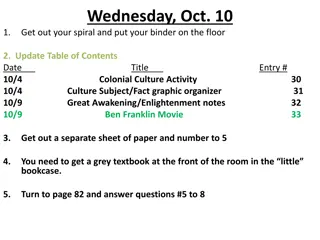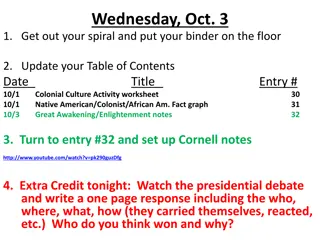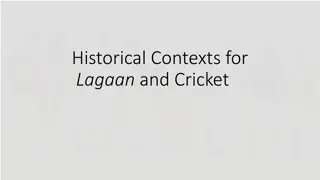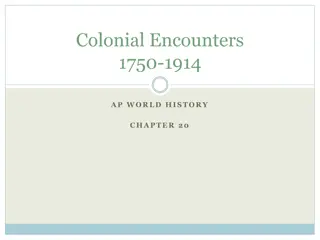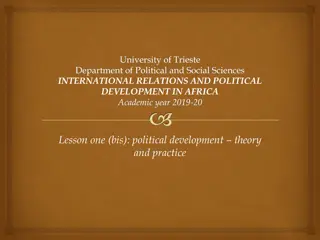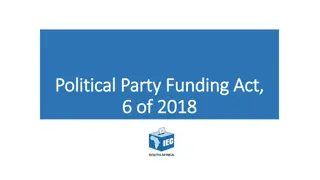Language Controversy and Political Awakening in Colonial India
Urdu-Hindi language controversy in colonial India sparked a significant cultural and political divide between Hindus and Muslims, leading to the emergence of the Two-Nation Theory. This controversy, along with events like the formation of the Indian National Conference, highlighted growing tensions and resistance against British colonial policies.
- Language Controversy
- Colonial India
- Two-Nation Theory
- Indian National Conference
- Political Awakening
Download Presentation

Please find below an Image/Link to download the presentation.
The content on the website is provided AS IS for your information and personal use only. It may not be sold, licensed, or shared on other websites without obtaining consent from the author. Download presentation by click this link. If you encounter any issues during the download, it is possible that the publisher has removed the file from their server.
E N D
Presentation Transcript
UNIT 4 Struggle for Pakistan
Urdu Hindi Controversy During the last days of the Muslim rule, Urdu emerged as the most common language of the northwestern provinces of India. It was declared the official language, and all official records were written in this language. In 1867, some prominent Hindus started a movement in Banaras in which they demanded the replacement of Urdu with Hindi, and the Persian script with the Deva Nagri script, as the court language in the northwestern provinces.
CONT The reason for opposing Urdu was that the language was written in Persian script, which was similar to the Arabic script, and Arabic was the language of the Quran, the Holy Book of the Muslims. The movement grew quickly and within a few months spread throughout the Hindu population of the northwestern provinces of India. The headquarters of this movement were in Allahabad.
CONT This situation provoked the Muslims to come out in order to protect the importance of the Urdu language. The opposition by the Hindus towards the Urdu language made it clear to the Muslims of the region that Hindus were not ready to tolerate the culture and traditions of the Muslims.
CONT The Urdu-Hindi controversy had a great effect on the life of Sir Syed Ahmad Khan. Before this event he had been a great advocate of Hindu-Muslim unity and was of the opinion that the two nations are like two eyes of the beautiful bride, India . But this movement completely altered his point of view. He put forward the Two-Nation Theory, predicting that the differences between the two groups would increase with the passage of time and the two communities would not join together in anything wholeheartedly.
Formation of Indian National Conference
Indian National Conference Events like the: passage of the Vernacular Press Act in 1878 and the Ilbert Bill of 1882, as well as the reduction of the age limit for the Civil Services Exams in 1876 resulted in a wave of opposition from the middle class Indians.
CONT Consequently some of them came together and formed a number of small political parties that came out in the streets for protests and rallies. The British foresaw the situation resulting in another rebellion on the pattern of the War of Independence of 1857.
CONT To avoid such a situation, the British decided to provide an outlet to the local people where they could discuss their political problems. In order to achieve this goal, Hume, a retired British civil servant, had a series of meetings with Lord Dufferin, the Viceroy. He also visited England and met people like John Bright, Sir James, Lord Ripon and some members of the British Parliament. Hume also had the support of a large number of Englishmen in India.
CONT After the War of Independence 1857 the English government had realized that their policy to rule by force was no longer beneficial in India. Thus, they tried to win the support of the Indian people. Several promises were made by the government that the Indians will, from now onward, also be a part of political affairs in their country and that they will no longer be treated as mere slave/masses but as citizens.
CONT During these circumstances an ex English CSP officer named Alan Octavian Hume came up with the idea of forming a political party, of the Indians and for the Indians. For that purpose he met with senior English bureaucrats and with their guidance, along with local Indian contribution a political party was formed in 1885. It was called the All Indian National Congress. Its first president was an Indian and Mr. Hume was its first general secretary.
Establishment of Indian National Congress On his return from Britain, Hume consulted the local Indian leaders and started working towards the establishment of an Indian political organization. He invited the convention of the Indian National Union, an organization he had already formed in 1884, to Bombay in December 1885. Seventy delegates, most of whom were lawyers, educationalists and journalists, attended the convention in which the Indian National Congress was established.
CONT This first session of Congress was presided over by Womesh Chandra and he was also elected as the first president of the organization. To begin with, Congress acted as a Kings Party .
Objectives Its early aims and objectives were: To seek the cooperation of all the Indians in its efforts. Eradicate the concepts of race, creed and provincial prejudices and try to form national unity. Discuss and solve the social problems of the country. To request the government, give more share to the locals in administrative affairs.
CONT As time went by, the Congress changed its stance and apparently became the biggest opposition to the British government. Muslims primarily opposed the creation of Congress and refused to participate in its activities.
CONT Out of the 70 delegates who attended the opening session of the Congress, only two were Muslims. Sir Syed Ahmad Khan, who was invited to attend the Bombay session, refused the offer. He also urged the Muslims to abstain from the Congress activities and predicted that the party would eventually become a Hindu party and would only look after the interests of the Hindus. Syed Ameer Ali, another important Muslim figure of the era, also refused to join Indian National Congress.
Congress and Muslims of India On 28thDecember 1885 the first session of the Congress was held with 72 members among whom, 58 were Hindus of which only 2 were Muslims. This obvious difference in the ratio of membership continued throughout the history of the Congress s existence as the only political party in the Indian sub- continent. For instance in the Congress session held in 1894 there were 118 Hindu members of Congress and only 20 were Muslims. The difference of proportion between the two nations representatives can show a great deal of truth about the intentions of the Congress.
CONT The chief Muslim leaders in India at that time were Sir Syed Ahmed Khan and his Aligarh comrades who believed that the English government was accusing Muslims to be the real force behind the mutiny of 1857 . According to Sir Syed, Muslims should stay aloof from all political matters to give the government the impression that they were not concerned with the politics so that they can save themselves from the government s wrath.
CONT Attainment of modern western education was the focus of the educated sections of Muslim society. The rest of the Muslim population was either too unaware of the current political affairs because of their educational backwardness or too afraid for their lives.
CONT Congress on the other hand started to become more and more prejudiced against the Muslims. Hindus, being in majority in the party started using it to achieve their own ends. The Congress during all her life in united India kept claiming that it represented all the communities living in India no matter what their faiths were. But the reality was quite the opposite.
Muslims of India During the last decade of the 19thcentury Congress and its policies became excessively biased and violent toward the Muslims. Extremist Hindus like Tilak, Medan Mohan Malvia, Rash Behari Ghosh and Banerjee became its major leaders who practically took arms against the Muslims, their faith and practices. Their violent protests against cow slaughter and division of Bengal are living proofs of Congress s pro-Hindu approach.
CONT Those were terrible times for all Indians except Hindus of course, and particularly for Muslims. Congress during its rule did all in its capacity to work against Muslims and their representative political party Muslim League. Hindu-Muslim riots were common stories of the day in which the Muslims were always accused for everything. Cow slaughter was banned in many regions. Congress party song Banday Mataram was declared the national anthem of India which branded all Muslims as outsiders and traitors and the song suggested the elimination of Muslims by all means.
CONT The language controversy was given a new life during that time as well. All these events proved that all Congress wanted was to destroy Muslims, their heritage and to rule them as masters over slaves. That s why when Congress ministries resigned in 1939; Muslims of India celebrated Day of Deliverance on 22ndDecember.
CONT In spite of all anti-Muslim activities of the Congress, some Muslim politicians had stuck their desires with the part because they agreed with the claim of the Congress that all the people living in India were one nation and Congress planned to keep it that way.
CONT Muslim politicians like Maulana Azad, Maulan Mohammad Ali Johar and even Mohammad Ali Jinnah were also in favor of united India and they believed that in spite of all the newly emerging Hindu-Muslim differences there was still the chance of their unity and that s why they remained with the Congress.
All India Muslim League On the Aligarh side, after the death of Sir Syed, his successors like Mohsin-ul-Mulk and Wiqar-ul-Mulk perceived that the time for Muslim separation from politics was gone and a new era had begun, that demanded a political party for the Muslims as well. For that reason in 1906 All India Muslim League was formed which in contrast to the Congress declared itself to be the representative of the Muslims
The Congress doings intensified the feelings of freedom of the Muslims and though Muslims like Maulana Azad and his party Jamiat-ul- Ulema-i-Hind kept themselves on the Congress side and hailed for a united India the majority of the Indian Muslims followed Muslim League and finally founded an independent country for themselves called Pakistan in 1947.
Introduction The partition of Bengal was the most important event during the rule of Lord Curzon. It was carried out mainly for the convenience of administration. Bengal in those days was the biggest province of India extending over 1, 89, 000 square miles with a population of 80 million. It was comprising of Bengal, Behar and Orissa and was under the central of one lieutenant Governor. After Lord Curzon took charge as Governor General of India the discussion over the Partition began due to the following issues:
Vastness of Province: The Province was spread over the area of 1, 89, 000 square miles with the population of 80 million, which was too vast to be managed by one lieutenant Governor. He could not make a tour for the whole province due to its vastness once in his tenure.
Limited Sources of Communication The sources of communication in the provinces were limited due to rivers and forests. The law and order condition of the provinces was also worst due to insufficient police and in-efficient management. Therefore the need of partition of province was felt severally.
Difference of Language: There was also the difference of Languages and civilization of the natives of West Bengal and East Bengal. The natives of West Bengal considered themselves superior in civilization to the resident of East Bengal. The Condition demanded for the division of Provinces.
Need of the time The division of Bengal was the need of the time to develop trade in East Bengal and to promote the Port of Chittagong, which could be done only by division of the Provinces.
Partition: The Partition of Bengal was thus calculated to restore efficiency in the Government and administration on one hand and encouraged local initiatives for progress and development on the other. Lord Curzon partitioned Bengal and formed two new provinces of manageable size East and West Bengal.
CONT East Bengal consisted of Dacca, Mamansingh, Assam, Kaula, Rangpur, and Bogra district, the Dacca was capital of East Bengal constituted a majority Muslim Province, while the Bihar and Orissa constituted a separate province to be called as West Bengal with the capital of Calcutta and become the Hindu Majority provinces.
Population East Bengal contained a population of eighteen million Muslims and twelve million Hindus. Whereas West Bengal had a population fifty four million of which 42 million where Hindus and thus was the Hindu majority province.
Muslims Response It received a favorable response from the Muslims. It was thought that it would bring the emancipation of Muslims socially and economically. The Muslims welcomed the Partition of Bengal for the following reasons: 1. In the majority province of East Bengal the Muslims would be free from Hindu dominance in economic field. They would get opportunities of services and advancement of agriculture.
CONT 2. The city of Dacca, where the Muslims were in majority was the centre of Muslim culture. In Dacca Muslims had a great chance of success for social and cultural advancement than in Calcutta. 3. The Partition could result in political uplift and securing representation in the Government. 4. The partition of Bengal relieved the Muslims from competing with Hindus, who were more advanced in every field of life.
Hindus Response The Hindus did not accept it, as it dealt a telling blow to their monopolies and exclusive hold on economic, social, Political life of the whole of Bengal. They called it as a deliberate attempt by British Government . 1. The Partition of Bengal had brightened the possibility of betterment of Muslims; while the Hindu landlords, capitalists and traders wanted status quo and to continue the exploitation of the Muslims.
CONT 2. Hindu lawyers also reacted to the partition of Bengal because they thought that the new province would have its separate courts and thus their practice would be affected. 3. Hindu press was not different from that of Hindu advocates. Hindus had their monopoly over almost whole of the province press. They were afraid that new newspapers would be established which would decrease their income naturally.
CONT 4. The Hindus launched Swadeshi Movement whose sole purpose was to boycott of British goods.
Annulment of the Partition When Lord Hardings assumed charge as Governor General of India Hindus again became active and sent a representation to him for the annulment of partition of Bengal. He recommended the same to the British Prime Minister for Indian Affairs. On the occasion of the visiting His Majesty George V to Indo- Pakistan and holding of Darbar at Delhi on 12th December 1911 the partition of Bengal was cancelled. The united Bengal was placed under a Governor and Assam was placed under a Chief Commissioner. This decision was shattering blow to Muslims. It left them sullen and disillusioned. Their anger and indignation had widespread repercussions. The Muslims leaders and intelligentsia condemned the decision as betrayal of worst kind.
CONT The united Bengal was placed under a Governor and Assam was placed under a Chief Commissioner. This decision was shattering blow to Muslims. It left them sullen and disillusioned. Their anger and indignation had widespread repercussions. The Muslims leaders and intelligentsia condemned the decision as betrayal of worst kind.
REASONS FOR PARTITION The reason behind the partition that was officially announced was that the Bengal province was too large to be administered by a single governor and therefore was partitioned on administrative purpose. But the real reason behind the partition was political and not administrative. East Bengal was dominated by the Muslims and West Bengal by the Hindus.
